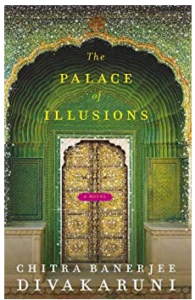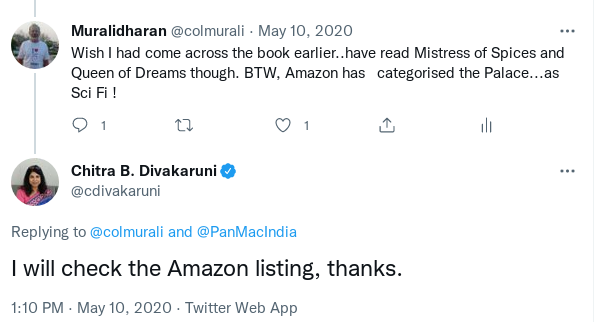

Palace of illusions falls in the genre of “No man’s land” . Historical fiction ? Mythology ?, History ? Or just fiction? Amazon groups most of such literature under main head Science Fiction , Horror and Fantasy and subhead Fantasy . Does it mean fiction is not fantasy ?
In a way, what is fiction but creative, imaginative narration of real life incidents with added twists and turns to make it dramatic and spell binding and fantasy gives unbridled flow to narration.
I go by this definition of Fantasy . Fantasy is a sub-genre of fiction. It refers to a branch of fiction which usually takes place in a world displaced from ours in either place or time. It has elements of the supernatural, including elements of magic, talking bears and dragons and so on.
So should we then call it historical fantasy ?
The Palace of Illusions is the story of Mahabharatam , in a way it would appeal even to a young reader. Indian mythology is very amenable to creative story telling. To quote the author , “a story gains power with retelling.” So we do have a very powerful story here.
I have read many versions at least once and one version by Rajagoplachari, “Vyasar Virundhu” in Tamil countless times. Mahabharatham is like a Matryoshka doll, with stories within stories going on and on. Virtually there is an explanation for anything happening anywhere as a fall out of something that happened in a different time and space. That is the theory of karma in all its glory.
As for readability, the most boring version is, predictably , the original one; no not in Sanskrit but the English translation by Kisari Mohan Ganguli. Almost every sentence is so convoluted with lengthy adjectives and honorifics for each character even in a routine conversation. Some examples :-
“Saying this the mild-speeched Krishna hid her face with her soft hands like the buds of lotus, and began to weep. And the tears of Panchali begot of grief washed her deep, plump and graceful breasts crowned with auspicious marks.”
“When Yudhishthira said this, his beloved queen. the high-minded Krishna of sweet smiles, answered him.”
(Krishnaa is another name of Draupadi)
So, we do need the story to be told and re-told in any number of styles, in prose, poetry and drama. The Palace of Illusions starts with the birth or the appearance of Draupadi at King Drupad’s yagya. (sacrifice) . What makes this narration special is that it is told as seen though the eyes of the main female character , Draupadi or Paanchaali.
Right from the start there is the focus on her being born with a destiny to fulfill. In her growing up years (some say that Draupadi was already an adult when she came out of the sacrificial fire) there is elation and there is anxiety and her chance encounter with the great sage Vyasa , rather than putting her at ease, only causes more anxiety .
Despite the prophesies ,as events unfold , she finds herself in no position to change the course of her unusual life. She is probably the only one among gods, gandharva , yakshas and the mortals , who is married to five men. She knows that her destiny would drive her to be the cause of the greatest war on earth and the end of an eon.
No single character can be aware of everything happening over a large canvas of time and space. So our protagonist gets a boon of divya- drishti (divine power to see everything) from the sage Vyasa and the Queen of Dreams dreams up the parts required to cover the gaps in the story. In a way Draupadi becomes the fourth know-all in the story after, Krishna, Vyasa and Bhishma.
The title says it all. Palace of illusions at Indraprastha is central to Paanchaali’s reign as the Queen of Pandava Kingdom. Though this period spans 36 years , most versions give just a broad-brush treatment to this phase barring the Rajasuya Yagya which is at the fag end of the period.
I am going on and on about Mahabharatam in general rather than about this book; but I can’t help it. While reading, there is always a stream of thoughts in the backdrop from various versions, as one looks for similarities and variances. What stands out in the Palace of Illusions is the total familiarity bordering on utter irreverence shown to the great heroes and even gods. This makes the characters look more human and the book more readable.
Just a few examples:-
About Yudhistra
“Was he a saint, or merely lacking in common sense? In either case, it was most annoying.”
About Arjuna
“For once, my much-wedded husband (aided by a dig from my elbow in his ribs) made the right decision: he asked that the princess become, instead, his son Abhimanyu’s wife.”
Krishna, an Avtar of Vishnu is singled out for special treatment . There is levity and facetiousness where-ever Krishna comes on the scene.
That’s how the famous Geethopadesh at Kurukshetra is described !
“When I watched Krishna advise Arjun, consoling him, teaching him how to be successful not only on this battlefield but beyond it, I almost didn’t recognize the amusing, carefree man I’d known since my girlhood. Where had he learned so many philosophies? When had he made their wisdom his own?”
What is a story without a love triangle ? May be in this case it could be a love – hexagon or is it love-polygon , what with Paanchaali talking about the wives of her husbands ! Karna angle is the most unexpected one in the polygon.
Over all, It’s a great read; awesome story telling and absolutely fascinating style. Just wondering ,how would the story have gone, if other strong female characters like Kunti , Gaandhari or even Rukmini had also insisted on voicing their viewpoints .
PS
The book is best enjoyed if you have a good knowledge of Indian Mythology in general. Unlike Ramayanam, Mahabharatham provides scope for threadbare analysis of all the characters. No one including Krishna is beyond reproach. For further reading / viewing I would suggest Gurcharan Das’s “Difficulty of being good “ and the serial “Dharmakshetra” on Epic Channel. Here’s one episode.
follow through…..


I read Devdutt Pattanaik’s weekly column on Saturday’s Economic Times. Fascinating is the way that he draws the interest of some hard nosed people by his way of weaving mythology with facets of everyday life.
Fantasy, day dreaming are the other instruments by which the human mind reaches beyond the physical dimensions of what the eyes see and the ears hear!
I loved the quote on Krishna, “Where had he learned so many philosophies? When had he made their wisdom his own?”
I am no Krishna and have no wisdom but yet yearn to seek it…
Interesting introduction to’ The Palace of Illusions’ by Chitra Banerjee Divakaruni. Makes one want to read the book and enjoy it fully.
Keep up your good work, Murali!
Best Wishes!